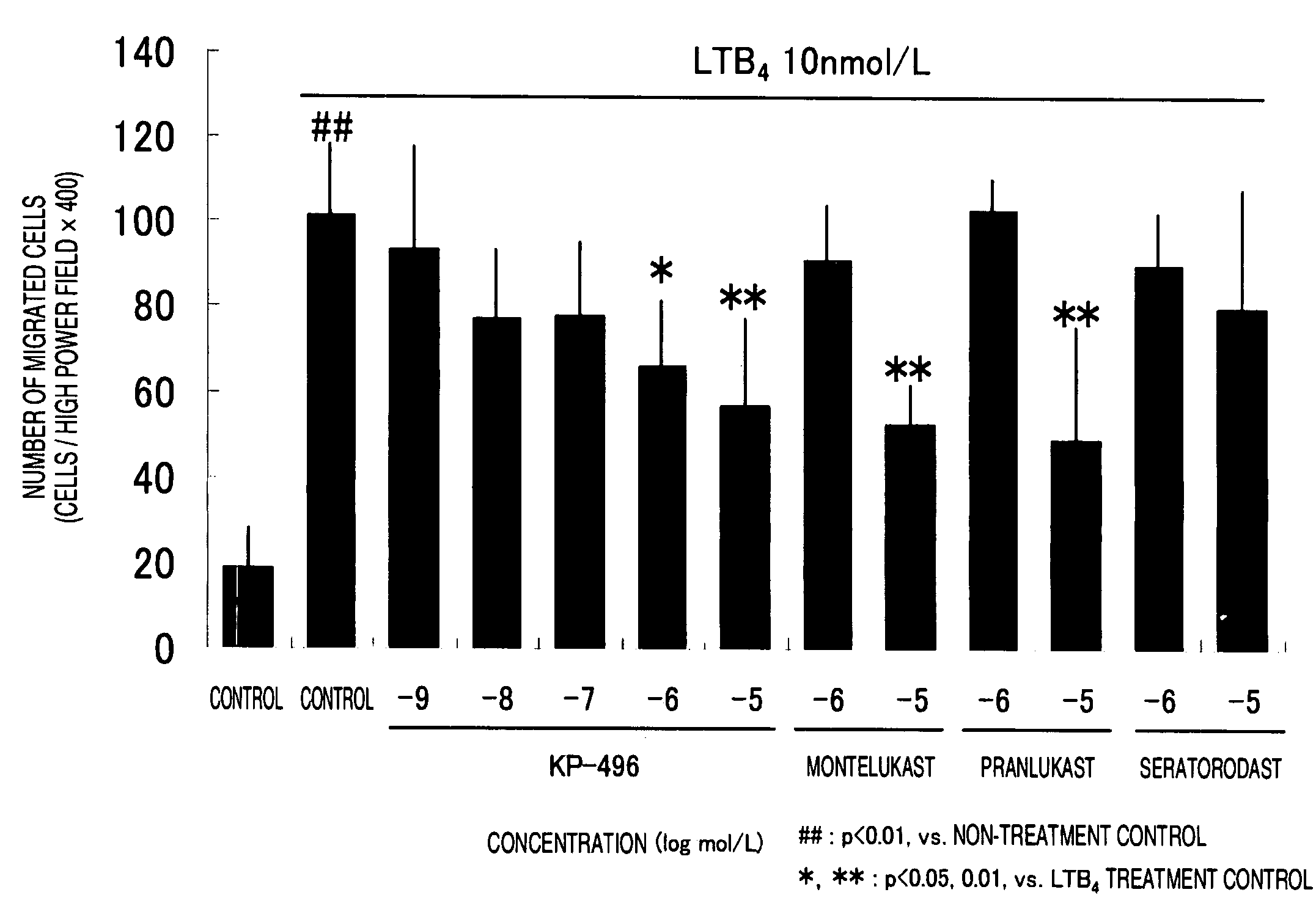Preventive or Therapeutic Agent for Chronic Inflammatory Lung Disease
a technology of inflammatory lung disease and therapeutic agent, which is applied in the direction of biocide, drug composition, animal husbandry, etc., can solve the problems of idiopathic interstitial pneumonia without established therapy, agents presently have problems, and chronic inflammation, so as to reduce the blm-induced acute inflammation, suppress the infiltration of inflammatory cells, and reduce the effect of a marker
- Summary
- Abstract
- Description
- Claims
- Application Information
AI Technical Summary
Benefits of technology
Problems solved by technology
Method used
Image
Examples
example 1
Suppressive Effect of KP-496 on Migration of Human Neutrophils
1. Method
[0056]a) Preparation of Human Leukocytes
[0057]Leukocytes were collected from human peripheral blood samples (20 mL of venous blood was taken by a doctor) were obtained from 4 healthy adults (male). They received sufficient information on the purpose of the experiment and gave informed consent in advance. An equivalent amount of 3% dextran (M.W. 208000) saline solution was added to the heparinized blood thus obtained and the mixture was kept to stand for one hour. Thereafter, the supernatant was collected and centrifuged at 150 g for 5 minutes at 4° C. The supernatant was discarded and the pellet was repeatedly twice haemolysed. To explain in detail, 4 mL of an ice-cooled 0.2% NaCl solution was added, quickly suspended and allowed to stand for 20 to 30 seconds. Thereafter, 4 mL of an ice-cooled 1.6% NaCl solution was added to the suspension solution to return the solution to the isotonic condition. After centrifug...
example 2
Pharmacological Effect of KP-496 on Interstitial Pneumonia and Pulmonary Fibrosis
1. Method of Experimental BLM-Induced Pulmonary Fibrosis Model in Mice
[0064]a) Induction of Animal Model of Disease and Medicament Administration
[0065]Bleomycin chloride (BLM) was dissolved in a physiological saline solution (saline). BLM was intravenously administered to 10-week-old ICR-strain male mice once in a dose of 150 mg / 10 mL / kg to induce disease. To a non-BLM administration group, saline was administered, instead. KP-496 was administered by inhalation twice a day from the initiation date of BLM administration to the day before autopsy. To describe in brief, a mouse housed in a polyethylene container under unrestrained conditions was allowed to spontaneously inhale a mist state of KP-496 solution (0.5 w / v %) nebulized by a nebulizer for 30 minutes. Furthermore, the vehicle (saline) for KP-496 was administered by inhalation to a control group, in the same manner. A group consisted of 8 animals.
[...
example 3
Pharmacological Effect of KP-496 on Pulmonary Emphysema
1. Method of Experimental PPE-Induced Pulmonary Emphysema Model in Mice
[0091]a) Induction of Animal Model of Disease and Medicament Administration
[0092]Eight-week old C57BL strain mice were anaesthetized with isoflurane. PPE (25 μg) was administered once to the lung through a cannula inserted into the trachea through the pharyngolarynx to induce a pulmonary damage. To a non-PPE administration group (normal group), saline was administered instead. In a preventive administration experiment (hereinafter referred to as a “preventive experiment”) of KP-496, drug effect was evaluated on inflammatory cells in BALF 2 days after PPE administration and by histopathological examination of the lung after 10 days. In a therapeutic administration experiment of KP-496 (hereinafter referred to as a “therapeutic experiment”), the drug effect was evaluated by histo-pathological examination of the lung and weight of the organs 14 days after PPE ad...
PUM
| Property | Measurement | Unit |
|---|---|---|
| Therapeutic | aaaaa | aaaaa |
Abstract
Description
Claims
Application Information
 Login to View More
Login to View More - R&D
- Intellectual Property
- Life Sciences
- Materials
- Tech Scout
- Unparalleled Data Quality
- Higher Quality Content
- 60% Fewer Hallucinations
Browse by: Latest US Patents, China's latest patents, Technical Efficacy Thesaurus, Application Domain, Technology Topic, Popular Technical Reports.
© 2025 PatSnap. All rights reserved.Legal|Privacy policy|Modern Slavery Act Transparency Statement|Sitemap|About US| Contact US: help@patsnap.com



